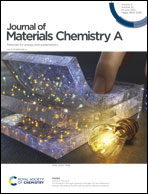Boosting CH4 selectivity in CO2 electroreduction using a metallacycle-based porous crystal with biomimetic adaptive cavities†
Abstract
There is a growing interest in designing electrocatalysts for highly selective electroreduction of CO2 to deeply reduced products such as CH4. However, CO2-to-CH4 conversion remains a great challenge in controlling the multi-electron/proton transfer and the adsorption of key intermediates. In this work, a metallacycle-based porous crystal (1) was synthesized for selective CO2-to-CH4 electroconversion in aqueous solution. The single-crystal analysis results disclosed that the metallacycle module of 1 features open metal sites and could be self-adaptive to encapsulate guest molecules of different sizes in its cavity. These enable the metallacycle to function as a nano-reactor to mimic the enzymatic cavity that is surrounded by catalytically active sites and adaptively bind to diverse substrates and intermediates. Accordingly, 1 exhibits desirable CO2 capture capacity, and its porous framework further promotes CO2 diffusion to catalytic sites. The above merits bring about an excellent CH4 selectivity of 70% with a partial current density of 10.3 mA cm−2 in a H-type cell at −1.5 V (versus the reversible hydrogen electrode), while a CH4 selectivity up to 81% with a partial current density of 23 mA cm−2 in a flow cell. Mechanistic investigations suggested that the adaptive cavity and the synergistic effect of aromatic hydrogen atoms, via hydrogen-bonding interactions, are beneficial to stabilize the key intermediates of CO2-to-CH4 conversion. This work develops a novel platform to regulate the reactivity and selectivity of CO2 electroreduction reactions.



 Please wait while we load your content...
Please wait while we load your content...